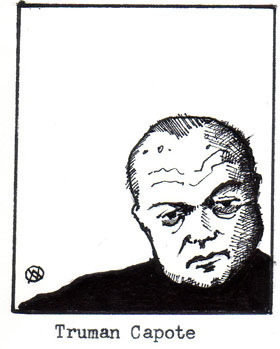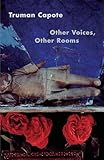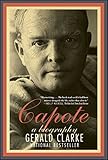 In all of American letters there is no tale sadder than the biography of Truman Capote. A true prodigy, Capote was publishing stories in national magazines by his early twenties, and published his first novel at age 24. After dabbling in writing for the theater and the movies, he returned to prose, first with the classic 1958 novella Breakfast at Tiffany’s, and then eight years later, his masterpiece, the “nonfiction novel” In Cold Blood, about the senseless killing of a Kansas farming family.
In all of American letters there is no tale sadder than the biography of Truman Capote. A true prodigy, Capote was publishing stories in national magazines by his early twenties, and published his first novel at age 24. After dabbling in writing for the theater and the movies, he returned to prose, first with the classic 1958 novella Breakfast at Tiffany’s, and then eight years later, his masterpiece, the “nonfiction novel” In Cold Blood, about the senseless killing of a Kansas farming family.
And then…nothing, or very near to it. Capote lived 18 years after the publication of In Cold Blood, much of which he spent working on a novel with the painfully ironic title Answered Prayers. When he published a few chapters of the book in Esquire, the real-life counterparts of his characters, many of them wives of business titans who had brought Capote into their glamorous circle, were so offended they shunned him. If there was ever any more of that novel than those controversial opening chapters, he never showed them to anyone. Instead, he got fat, grew estranged from his long-suffering lover Jack Dunphy, and bounced from lover to lover, living as a sad, lonely has-been until his death in 1984 from liver disease.
 But before his wilderness years, before his cringeworthy turn in the Neil Simon movie Murder by Death, before the six years it took him to write the true-crime thriller that made his name and destroyed his health, there was the charming, coquettish boy-man whose bedroom eyes stared back at readers in the famous jacket photo for his first novel, Other Voices, Other Rooms. “A Beautiful Child,” is the title of a gossipy memory piece Capote wrote about Marilyn Monroe, but his descriptions of his female subjects always contained more than a few brushstrokes of self-portraiture, and for more than a decade, from the publication of his first stories in the mid-1940s until he set out for Holcomb, Kansas, to investigate the quadruple-murder of the Clutter family in 1959, that’s who Capote was: American literature’s beautiful child.
But before his wilderness years, before his cringeworthy turn in the Neil Simon movie Murder by Death, before the six years it took him to write the true-crime thriller that made his name and destroyed his health, there was the charming, coquettish boy-man whose bedroom eyes stared back at readers in the famous jacket photo for his first novel, Other Voices, Other Rooms. “A Beautiful Child,” is the title of a gossipy memory piece Capote wrote about Marilyn Monroe, but his descriptions of his female subjects always contained more than a few brushstrokes of self-portraiture, and for more than a decade, from the publication of his first stories in the mid-1940s until he set out for Holcomb, Kansas, to investigate the quadruple-murder of the Clutter family in 1959, that’s who Capote was: American literature’s beautiful child.

 This month Random House is celebrating the work of this gifted and tragic boy genius with a handsome new Modern Library edition of Breakfast at Tiffany’s and Other Voices, Other Rooms. In May, the Modern Library will bring out a new edition of his Complete Stories, many of which were written during his early career. The justification for these new editions is slim at best. Breakfast at Tiffany’s turns 55 this year, but today many more people know the movie with Audrey Hepburn than have read Capote’s original novella. Capote himself is now best known as the flamboyantly gay elf with a squeaky voice played first by Philip Seymour Hoffman and then by Toby Jones in the competing movie versions of the tale of Capote’s experiences reporting and writing In Cold Blood.
This month Random House is celebrating the work of this gifted and tragic boy genius with a handsome new Modern Library edition of Breakfast at Tiffany’s and Other Voices, Other Rooms. In May, the Modern Library will bring out a new edition of his Complete Stories, many of which were written during his early career. The justification for these new editions is slim at best. Breakfast at Tiffany’s turns 55 this year, but today many more people know the movie with Audrey Hepburn than have read Capote’s original novella. Capote himself is now best known as the flamboyantly gay elf with a squeaky voice played first by Philip Seymour Hoffman and then by Toby Jones in the competing movie versions of the tale of Capote’s experiences reporting and writing In Cold Blood.
If Capote the writer has been eclipsed in the public mind by Capote the Hollywood movie character, no one is more to blame than Capote himself. An incurable glory hog, Capote lived as much of his life as he could in the limelight, hopping onto the sofa of any TV talk show host who would have him and jetting around the world in the company of glamorous women from Babe Paley, wife of CBS President Bill Paley, to Elizabeth Taylor and Jackie Kennedy. Capote, in his way, was a reality TV star before there was reality TV, always on stage, gossiping and backstabbing, forever plotting to push other people off the island.
 Behind all that needy self-display, though, there was a serious, preternaturally confident author, one of the most naturally gifted America has ever produced. In his excellent and unbearably sad biography,Capote, Gerald Clarke recounts the story of the day in 1945 when Capote appeared at the offices of Mademoiselle with a short story he had had written. Capote was by then 21, but with his delicate features and high, girlish voice, he looked and sounded like a child, so when he told the fiction editor’s receptionist that he had a story he wished to submit, she told him, “That’s fine, little boy. Have you got your name and address on it?” Capote’s answer, now legendary, but also in keeping with his boundless confidence in his talent, was: “I’ll wait while they read it.” Within months, the magazine had published one of Capote’s best-known early stories, “Miriam,” a spooky little tale about a girl with an evil temper.
Behind all that needy self-display, though, there was a serious, preternaturally confident author, one of the most naturally gifted America has ever produced. In his excellent and unbearably sad biography,Capote, Gerald Clarke recounts the story of the day in 1945 when Capote appeared at the offices of Mademoiselle with a short story he had had written. Capote was by then 21, but with his delicate features and high, girlish voice, he looked and sounded like a child, so when he told the fiction editor’s receptionist that he had a story he wished to submit, she told him, “That’s fine, little boy. Have you got your name and address on it?” Capote’s answer, now legendary, but also in keeping with his boundless confidence in his talent, was: “I’ll wait while they read it.” Within months, the magazine had published one of Capote’s best-known early stories, “Miriam,” a spooky little tale about a girl with an evil temper.
The only child of an alcoholic mother and a big-talking traveling salesman father who landed in jail for writing bad checks, Capote spent much of his early life with relatives in the rural South and never went to college. His only real job, a brief stint as a copyboy for the New Yorker, ended when he was fired for walking out of a reading at the Bread Loaf Writers’ Conference by poet Robert Frost, a frequent contributor to the magazine. Without an education or meaningful connections in the literary world, the man-child who sat waiting for the editors at Mademoiselle to read his work, and the young writer who turned out stories those editors couldn’t ignore, was entirely self-invented, which may help explain the high-strung tone and quirky subject matter of the early stories, which seem designed to shock the reader into attention as much as to entertain or edify.
This is certainly true of Other Voices, Other Rooms, a self-consciously lurid tale of 13-year-old Joel Knox who sets off in search of his missing father and ends up in a kind of Warner Brothers back-lot stage set of Southern-fried weirdness, all swamplands and ruined Gothic splendor. Other Voices would be a forgettable bauble of mid-century Southern fiction had its author not gone on to be Truman Capote, and were it not so revealing of the passions and demons that fueled his later work. The novel’s hero, a transparent stand-in for its author, has been effectively orphaned, and when asked to pray, is stumped:
[A]ll his prayers in the past had been simple concrete requests: God, give me a bicycle, a knife with seven blades, a box of oil paints. Only how, how, could you say something so indefinite, so meaningless as this: God, let me be loved.
This is the leitmotif for Capote’s entire life and career. All his characters wish only to be loved, and finding it impossible to be loved in any conventional way, seek love wherever they can find it, sometimes creatively, sometimes in ways that destroy themselves or others. In Other Voices, Joel’s father is alive, but reduced to a pathetic grotesque, a quadriplegic kept in a box who can communicate only by dropping red tennis balls to telegraph his distress. Instead, Joel finds his father figure in his deliciously odd Cousin Randolph, who watches him from an upstairs window wearing a woman’s dress and towering white wig. At the novel’s end, Randolph in drag beckons to Joel from the window, and Joel, finally understanding who he is, goes to him “unafraid, not hesitating,” pausing only briefly to look back “at the boy he had left behind.”
If Other Voices allowed Capote a vicarious coming out, by the time of Breakfast at Tiffany’s ten years later, his sexuality was largely a settled issue. Readers coming to the novella for the first time – especially those who know only the movie version which turns Capote’s narrator into a sort of heterosexual rent boy who falls for the party girl Holly Golightly – may be surprised how unambiguously gay the novella’s narrator is. It is so obvious, so integral to his non-sexual intimacy with Holly, that it hardly bears mentioning, which allows Capote to focus on a different kind of doppelganger, the pretty young society girl who, like her creator, survives in New York on her ability to charm herself and those around her into believing she is as charming and beautiful as she wishes herself to be.
Yes, yes, Hepburn created an icon in her portrayal of Holly Golightly, with her little black dresses and her cigarette holder, but Capote’s original is so much richer, so much more interesting. The novella, with its cartoonishly named central characters, Holiday Golightly, Rusty Trawler, and Sally Tomato, is no more a realistic portrayal of New York in the war years than Other Voices is of the Depression-era South, but here the distortions bring one closer to the truth of what Manhattan meant to creative-class strivers of Capote’s generation. In Capote’s telling, New York is a kind of Emerald City, where all those hurt or looked down upon in their hometowns can come to reinvent themselves, except that here Dorothy herself is the Wizard of Oz, pulling the levers of fashion and witty talk that create the beautiful mirage.
Holly Golightly, Capote’s most enduring character, represents the creative side of his obsessive need to be loved. Born Lulamae Barnes in Tulip, Texas, and married off at the age of 14 to a local country doctor whom she soon abandons, Holly is a wholly self-invented figure. She makes her living off “tips” from her gentleman suitors, but she is not, strictly speaking, a whore, nor is her appeal merely sexual. She makes a place for herself by being a feminine chameleon, at once a sex kitten to the men who pay her tips, a surrogate daughter for the lonely mobster Sally Tomato whom she visits every week at Sing Sing, and a would-be American trophy wife for a Brazilian diplomat. When her act fails, and the police come after her for helping Sally Tomato run his criminal gang from behind bars, she vanishes, leaving behind nothing but her pet cat, resurfacing years later in Africa where a tribal artisan has fallen in love with her and carved her image into wood.
This, one senses, is the trick Capote himself was trying to pull off in his constant, almost compulsive, self-reinventions, from seductive boy-genius novelist, to Broadway playwright, to screenwriter, to journalist, to public personality and court jester of the most privileged circles of New York’s financial elite. But people, unlike fictional characters, are always themselves, and eventually their pasts catch up to them. This, for me, is the hidden story behind In Cold Blood. The book focuses on the murderer Perry Smith, yet another orphan with artistic tendencies – he wrote poetry and painted – but Smith, ugly and runted, doesn’t possess the talent or capacity for self-belief of a Holly Golightly, and when his dreams fail, he can’t take on a new life and so instead he destroys life. His target is an obvious one: a good, clean Kansan farming family whose love for one another is as real as it is conventional.
Looked at in this way, it isn’t hard to see why In Cold Blood so completely shattered Capote: in Perry Smith, and his check-kiting partner in crime Richard Hickock, Capote was encountering his nightmare image of himself, what he could become if he ever lost his chameleon-like talent. And, God love him, he reported it all honestly. Capote may have fudged a few details, but he stuck it out till the bitter end, telling in excruciating detail the events of that bloody November night in the Clutter home, and then staying with Smith and Hickok until they were hanged for their crimes.
In the sweeping narrative of twentieth century American literature, Capote is typically reduced to a colorful footnote, a young star who flared early and then collapsed in on himself, becoming a black hole of grasping need. In part, this is due to a prejudice against true-crime nonfiction, the genre in which he did his greatest work and indeed helped invent. There is probably no greater book on the darkness lurking in the American heartland than In Cold Blood, but because it shares a shelf with schlocky thrillers, it doesn’t get the critical respect it would if it were purely a work of imagination.
Ultimately, though, the damage to Capote’s literary reputation is mostly self-inflicted. True, he wrote two genre-defining works, Breakfast at Tiffany’s and In Cold Blood, along with some truly great stories, including the heartbreaking “A Christmas Memory.” But he could have done so much more. Capote is hardly alone in coming to a sad end. Ernest Hemingway shot himself in despair; Tennessee Williams, a contemporary and close friend of Capote’s, choked on a bottle cap after more than twenty years of creative failure. But they got their major work done. Capote didn’t. Yet for all this, he remains worth reading because unlike most self-deceiving people he was also a genius, and part of that genius was a capacity to look honestly at his own deceptions, even if in life he couldn’t help being misled by them.
Illustration by Bill Morris








